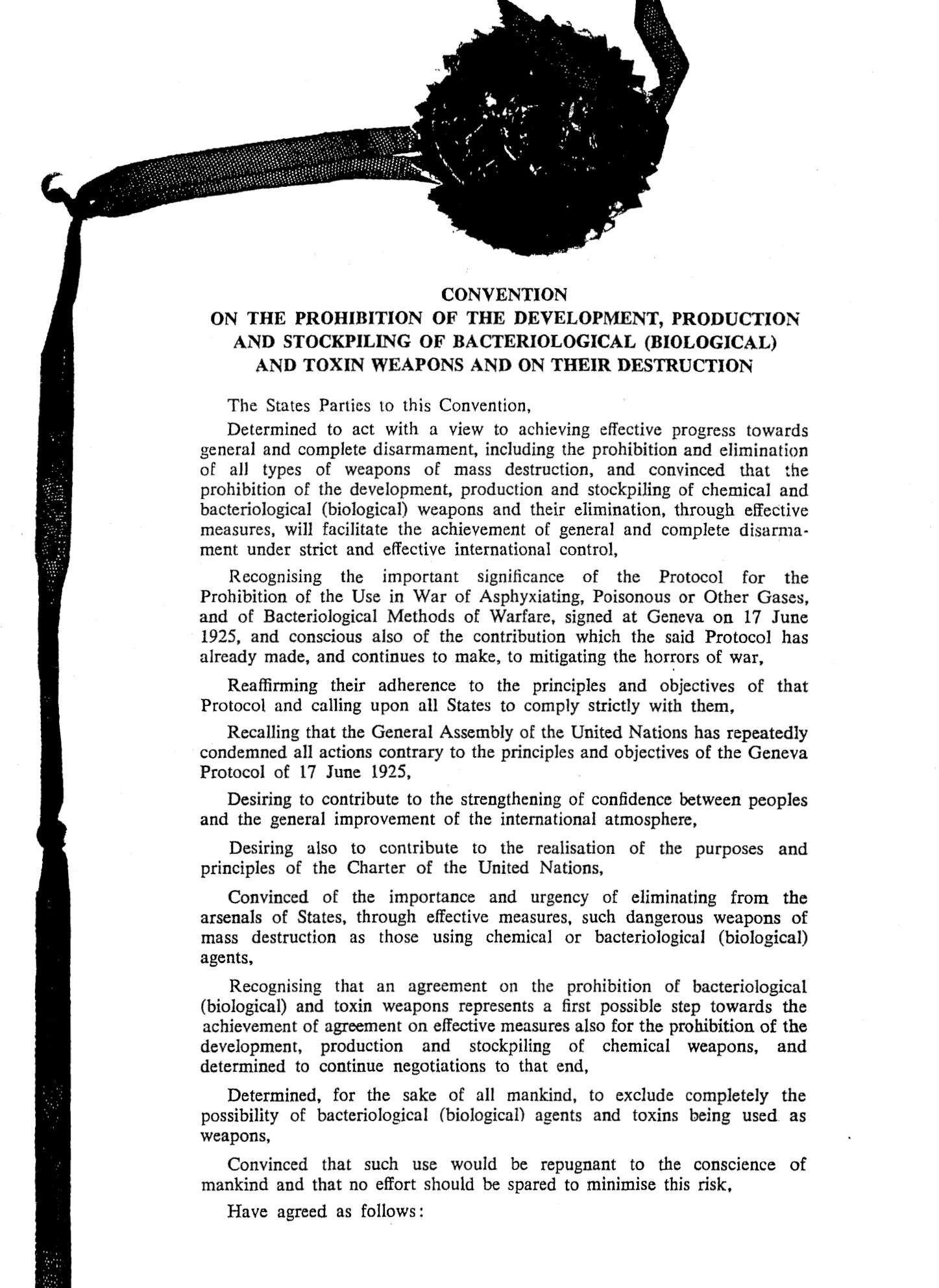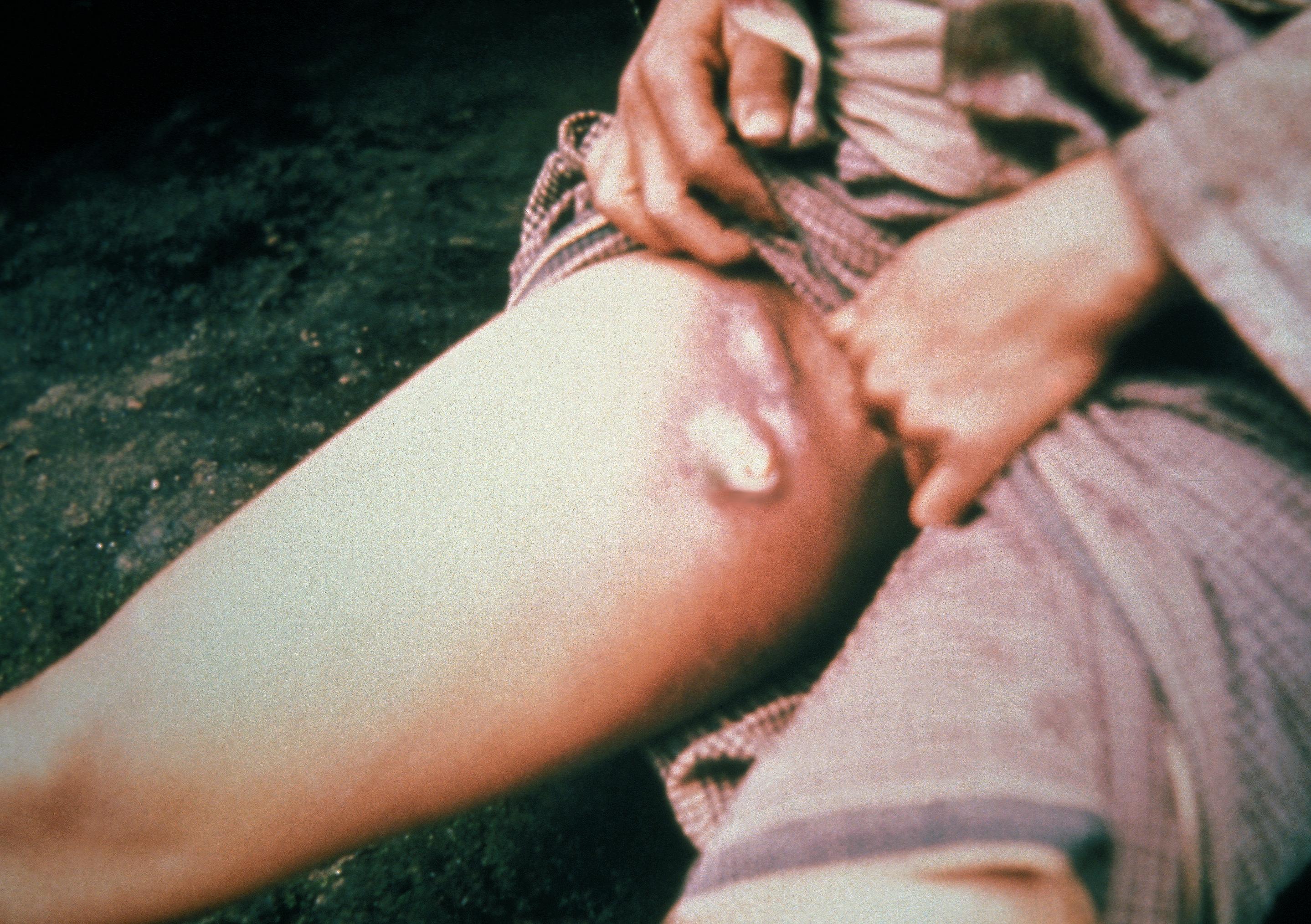|
Bioweapon
Biological agents, also known as biological weapons or bioweapons, are pathogens used as weapons. In addition to these living or replicating pathogens, toxins and biotoxins are also included among the bio-agents. More than 1,200 different kinds of potentially weaponizable bio-agents have been described and studied to date. Some biological agents have the ability to adversely affect human health in a variety of ways, ranging from relatively mild allergic reactions to serious medical conditions, including serious injury, as well as serious or permanent disability or death. Many of these organisms are ubiquitous in the natural environment where they are found in water, soil, plants, or animals. Bio-agents may be amenable to "weaponization" to render them easier to deploy or disseminate. Genetic modification may enhance their incapacitating or lethal properties, or render them impervious to conventional treatments or preventives. Since many bio-agents reproduce rapidly and require ... [...More Info...] [...Related Items...] OR: [Wikipedia] [Google] [Baidu] |
Anthrax
Anthrax is an infection caused by the bacterium '' Bacillus anthracis'' or ''Bacillus cereus'' biovar ''anthracis''. Infection typically occurs by contact with the skin, inhalation, or intestinal absorption. Symptom onset occurs between one day and more than two months after the infection is contracted. The skin form presents with a small blister with surrounding swelling that often turns into a painless ulcer with a black center. The inhalation form presents with fever, chest pain, and shortness of breath. The intestinal form presents with diarrhea (which may contain blood), abdominal pains, nausea, and vomiting. According to the U.S. Centers for Disease Control and Prevention, the first clinical descriptions of cutaneous anthrax were given by Maret in 1752 and Fournier in 1769. Before that, anthrax had been described only in historical accounts. The German scientist Robert Koch was the first to identify ''Bacillus anthracis'' as the bacterium that causes anthrax. Anthra ... [...More Info...] [...Related Items...] OR: [Wikipedia] [Google] [Baidu] |
United States Biological Weapons Program
The United States biological weapons program officially began in spring 1943 on orders from U.S. President Franklin D. Roosevelt. Research continued following World War II as the U.S. built up a large stockpile of biological agents and weapons. Over the course of its 27-year history, the program weaponized and stockpiled seven bio-agents '' Bacillus anthracis'' ( anthrax), '' Francisella tularensis'' ( tularemia), ''Brucella'' spp (brucellosis), '' Coxiella burnetii'' ( Q-fever), Venezuelan equine encephalitis virus, Botulinum toxin (botulism), and Staphylococcal enterotoxin B. The US also pursued basic research on many more bio-agents. Throughout its history, the U.S. bioweapons program was secret. It was later revealed that laboratory and field testing (some of the latter using simulants on non-consenting individuals) had been common. The official policy of the United States was first to deter the use of bio-weapons against U.S. forces and secondarily to retaliate if deterrenc ... [...More Info...] [...Related Items...] OR: [Wikipedia] [Google] [Baidu] |
Biological Weapons Convention
The Biological Weapons Convention (BWC), or Biological and Toxin Weapons Convention (BTWC), is a disarmament treaty that effectively bans Biological weapons, biological and toxin weapons by prohibiting their development, production, acquisition, transfer, stockpiling and use. The treaty's full name is the Convention on the Prohibition of the Development, Production and Stockpiling of Bacteriological (Biological) and Toxin Weapons and on their Destruction. Having entered into force on 26 March 1975, the BWC was the first multilateral disarmament treaty to ban the production of an entire category of weapons of mass destruction. The convention is of unlimited duration. As of May 2025, List of parties to the Biological Weapons Convention, 189 states have become party to the treaty. Four additional states have signed but not ratified the treaty, and another four states have neither signed nor acceded to the treaty.Report on universalization activities, 2019 Meeting of States Parties t ... [...More Info...] [...Related Items...] OR: [Wikipedia] [Google] [Baidu] |
Bioterrorism
Bioterrorism is terrorism involving the intentional release or dissemination of biological agents. These agents include bacteria, viruses, insects, fungi, and/or their toxins, and may be in a naturally occurring or a human-modified form, in much the same way as in biological warfare. Further, modern agribusiness is vulnerable to anti-agricultural attacks by terrorists, and such attacks can seriously damage economy as well as consumer confidence. The latter destructive activity is called agrobioterrorism and is a subtype of agro-terrorism. Definition Bioterrorism agents are typically found in nature, but could be mutated or altered to increase their ability to cause disease, make them resistant to current medicines, or to increase their ability to be spread into the environment. Biological agents can be spread through the air, water, or in food. Biological agents are attractive to terrorists because they are extremely difficult to detect and do not cause illness for severa ... [...More Info...] [...Related Items...] OR: [Wikipedia] [Google] [Baidu] |
Smallpox
Smallpox was an infectious disease caused by Variola virus (often called Smallpox virus), which belongs to the genus '' Orthopoxvirus''. The last naturally occurring case was diagnosed in October 1977, and the World Health Organization (WHO) certified the global eradication of the disease in 1980, making smallpox the only human disease to have been eradicated to date. The initial symptoms of the disease included fever and vomiting. This was followed by formation of ulcers in the mouth and a skin rash. Over a number of days, the skin rash turned into the characteristic fluid-filled blisters with a dent in the center. The bumps then scabbed over and fell off, leaving scars. The disease was transmitted from one person to another primarily through prolonged face-to-face contact with an infected person or rarely via contaminated objects. Prevention was achieved mainly through the smallpox vaccine. Once the disease had developed, certain antiviral medications could poten ... [...More Info...] [...Related Items...] OR: [Wikipedia] [Google] [Baidu] |
Botulism
Botulism is a rare and potentially fatal illness caused by botulinum toxin, which is produced by the bacterium ''Clostridium botulinum''. The disease begins with weakness, blurred vision, Fatigue (medical), feeling tired, and trouble speaking. This may then be followed by weakness of the arms, chest muscles, and legs. Vomiting, swelling of the abdomen, and diarrhea may also occur. The disease does not usually affect consciousness or cause a fever. Botulism can occur in several ways. The bacterial spores which cause it are common in both soil and water and are very resistant. They produce the botulinum toxin when exposed to low oxygen levels and certain temperatures. Foodborne botulism happens when food containing the toxin is eaten. Infant botulism instead happens when the bacterium develops in the intestines and releases the toxin. This typically only occurs in children less than one year old, as protective mechanisms against development of the bacterium develop after that age ... [...More Info...] [...Related Items...] OR: [Wikipedia] [Google] [Baidu] |
Bacillus Anthracis
''Bacillus anthracis'' is a gram-positive and rod-shaped bacterium that causes anthrax, a deadly disease to livestock and, occasionally, to humans. It is the only permanent (obligate) pathogen within the genus ''Bacillus''. Its infection is a type of zoonosis, as it is transmitted from animals to humans. It was discovered by a German physician Robert Koch in 1876, and became the first bacterium to be experimentally shown as a pathogen. The discovery was also the first scientific evidence for the germ theory of diseases. ''B. anthracis'' measures about 3 to 5 μm long and 1 to 1.2 μm wide. The reference genome consists of a 5,227,419 bp circular chromosome and two extrachromosomal DNA plasmids, pXO1 and pXO2, of 181,677 and 94,830 bp respectively, which are responsible for the pathogenicity. It forms a protective layer called endospore by which it can remain inactive for many years and suddenly becomes infective under suitable environmental conditions. Because of the resilience ... [...More Info...] [...Related Items...] OR: [Wikipedia] [Google] [Baidu] |
Plague (disease)
Plague is an infectious disease caused by the bacterium '' Yersinia pestis''. Symptoms include fever, weakness and headache. Usually this begins one to seven days after exposure. There are three forms of plague, each affecting a different part of the body and causing associated symptoms. Pneumonic plague infects the lungs, causing shortness of breath, coughing and chest pain; bubonic plague affects the lymph nodes, making them swell; and septicemic plague infects the blood and can cause tissues to turn black and die. The bubonic and septicemic forms are generally spread by flea bites or handling an infected animal, whereas pneumonic plague is generally spread between people through the air via infectious droplets. Diagnosis is typically by finding the bacterium in fluid from a lymph node, blood or sputum. Those at high risk may be vaccinated. Those exposed to a case of pneumonic plague may be treated with preventive medication. If infected, treatment is with antibiotics a ... [...More Info...] [...Related Items...] OR: [Wikipedia] [Google] [Baidu] |
Brucella Suis
''Brucella suis'' is a bacterium that causes swine brucellosis, a zoonosis that affects pigs. The disease typically causes chronic inflammatory lesions in the reproductive organs of susceptible animals or orchitis, and may even affect joints and other organs. The most common symptom is abortion in pregnant susceptible sows at any stage of gestation. Other manifestations are temporary or permanent sterility, lameness, posterior paralysis, spondylitis, and abscess formation. It is transmitted mainly by ingestion of infected tissues or fluids, semen during breeding, and suckling infected animals. Since brucellosis threatens the food supply and causes undulant fever, ''Brucella suis'' and other ''Brucella'' species (''B. melitensis, B. abortus, B. ovis, B. canis'') are recognized as potential agricultural, civilian, and military bioterrorism agents. Symptoms and signs The most frequent clinical sign following ''B. suis'' infection is abortion in pregnant females, reduced milk produ ... [...More Info...] [...Related Items...] OR: [Wikipedia] [Google] [Baidu] |
Centers For Disease Control And Prevention
The Centers for Disease Control and Prevention (CDC) is the National public health institutes, national public health agency of the United States. It is a Federal agencies of the United States, United States federal agency under the United States Department of Health and Human Services, Department of Health and Human Services (HHS), and is headquartered in Atlanta, Georgia. The CDC's current nominee for director is Susan Monarez. She became acting director on January 23, 2025, but stepped down on March 24, 2025 when nominated for the director position. On May 14, 2025, Robert F. Kennedy Jr. stated that lawyer Matthew Buzzelli is acting CDC director. However, the CDC web site does not state the acting director's name. The agency's main goal is the protection of public health and safety through the control and prevention of disease, injury, and disability in the US and worldwide. The CDC focuses national attention on developing and applying disease control and prevention. It e ... [...More Info...] [...Related Items...] OR: [Wikipedia] [Google] [Baidu] |
CB Military Symbol
Chemical, biological (CB) — and sometimes radiological — warfare agents were assigned what is termed a military symbol by the U.S. military until the American chemical and biological weapons programs were terminated (in 1990 and 1969, respectively). Military symbols applied to the CB agent fill, and not to the entire weapon. A chemical or biological weapon designation would be, for example, "Aero-14/B", which could be filled with GB, VX, TGB, or with a biological modification kit – OU, NU, UL, etc. A CB weapon is an integrated device of (1) agent, (2) dissemination means, and (3) delivery system. Military symbols can sometimes reflect the name of where a chemical agent is manufactured. For example, chloropicrin has the symbol PS, which was derived from the British town in which it was manufactured during the First World War: Port Sunlight. Chemical agents Blood agents *AC – hydrogen cyanide *CK – cyanogen chloride *SA – Arsine Choking agents ... [...More Info...] [...Related Items...] OR: [Wikipedia] [Google] [Baidu] |







